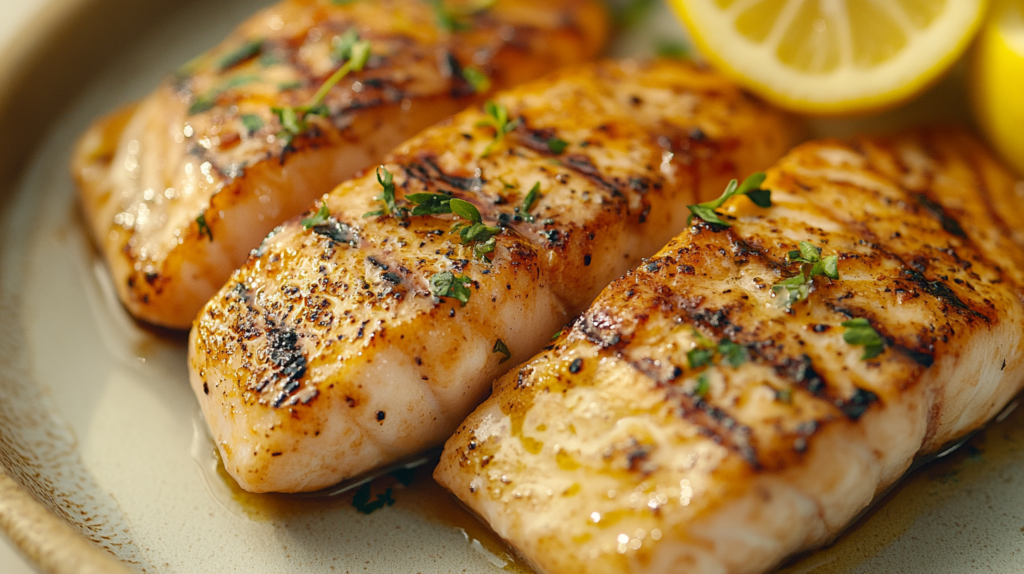Table of Contents
Introduction
Rockfish is a versatile seafood choice loved by both chefs and home cooks. The best ways rockfish can be prepared include pan-searing for a crispy finish, baking for a hassle-free meal, grilling to enhance its natural flavors, and steaming to retain its tenderness and nutrients. Predominantly found in the Pacific Ocean, rockfish offers unique textures and flavors across its many species. It is also a nutritional powerhouse, packed with protein, omega-3 fatty acids, and essential vitamins, making it an excellent addition to any diet.
In this article, we’ll explore the best ways to use this fillet, highlighting its culinary versatility, nutritional value, and creative applications beyond cooking. Whether you’re a seasoned seafood enthusiast or trying it for the first time, this guide offers tips, recipes, and insights to help you fully enjoy this remarkable fish.
Are you ready to enhance your culinary skills and learn more about rockfish? Let’s dive into everything you need to know about using it effectively, sustainably, and deliciously.
Understanding Rockfish
What is Rockfish?
Rockfish refers to a group of fish species primarily found in the North Pacific Ocean. Belonging to the genus Sebastes, they are prized for their firm, flaky flesh and mild flavor, making them popular in various cuisines. With over 70 species, they vary in size, appearance, and habitat. Common types include black, vermilion, and yelloweye fillet.
Rockfish are bottom-dwelling creatures, often found near rocky reefs and seafloors, hence their name. They are prized for their versatility, as their mild flavor adapts beautifully to various cooking styles and seasonings. Additionally, their texture allows them to hold up well in everything from grilling to soups.
Types of Rockfish and Their Uses
- Black one: Mild and flaky, ideal for baking or sautéing with light herbs and spices.
- Vermilion : Slightly richer in flavor, perfect for grilling or making fish tacos.
- Yelloweye: Firm and meaty, excellent for pan-searing or broiling.
- Canary: Slightly sweet, commonly used in soups or stews.
By understanding the unique characteristics of each species, you can select the right one for your desired dish and ensure the best culinary experience.
Nutritional Value of Rockfish
The fllet is not only delicious but also packed with essential nutrients. Here’s why it’s a fantastic addition to a healthy diet:
- High Protein Content: an excellent source of lean protein, essential for muscle repair and overall health.
- Rich in Omega-3 Fatty Acids: These healthy fats promote heart health, reduce inflammation, and support brain function.
- Low in Calories and Fat: ideal for those seeking a nutrient-dense, low-calorie meal.
- Loaded with Vitamins and Minerals: It’s a good source of vitamin D, selenium, and phosphorus, which are vital for bone health and immune function.
Incorporating fillet into your diet not only satisfies your taste buds but also contributes to your overall well-being.
Culinary Applications of Rockfish

Best Cooking Methods for Rockfish
Rockfish’s firm texture and mild flavor make it an ideal ingredient for a variety of cooking methods. Whether you’re preparing a quick weeknight dinner or a sophisticated meal for guests, rockfish adapts beautifully to different techniques. Here are some of the best ways to cook it:
Grilling Rockfish: A Flavorful Option
Grilling rockfish enhances its natural flavor with a smoky, charred finish. The firm flesh holds up well on the grill, preventing it from falling apart. To grill rockfish:
- Marinate the fillets with olive oil, lemon juice, garlic, and your favorite herbs (such as thyme or rosemary).
- Preheat the grill to medium-high heat and lightly oil the grates.
- Cook the fish for 3–4 minutes on each side, or until the flesh flakes easily with a fork.
Grilled rockfish pairs well with grilled vegetables, rice pilaf, or a crisp green salad.
Baking Rockfish for a Healthy Meal
Baking is an easy and nutritious way to prepare seafood, preserving moisture and enhancing its flavor. Follow these steps:
- Preheat your oven to 375°F (190°C).
- Place the fillet on a baking sheet lined with parchment paper.
- Season with salt, pepper, paprika, and a drizzle of olive oil. Add lemon slices and fresh herbs for extra flavor.
- Bake for 15–20 minutes, depending on the fillet’s thickness, until the flesh is opaque and flakes easily.
Pan-Seared Rockfish: Quick and Easy
Pan-searing rockfish creates a golden, crispy exterior while keeping the inside tender and juicy. This method is perfect for busy nights when you need a fast, flavorful dish.
- Pat the rockfish dry and season with salt and pepper.
- Heat a tablespoon of butter or oil in a non-stick skillet over medium-high heat.
- Sear the fillets for 3–4 minutes per side until golden brown and cooked through.
Serve pan-seared rockfish with a squeeze of fresh lemon juice and sides like sautéed spinach or mashed sweet potatoes.
Commonly Used Spices and Marinades
The mild flavor of rockfish allows it to take on a wide range of seasonings and marinades. Some popular combinations include:
- Mediterranean: Olive oil, garlic, oregano, and lemon zest.
- Asian-Inspired: Soy sauce, ginger, garlic, and sesame oil.
- Cajun: A spicy blend of paprika, cayenne pepper, garlic powder, and thyme.
Letting the fish marinate for at least 30 minutes before cooking enhances its flavor, making your dishes even more enjoyable.
Pairing Rockfish with Sides and Beverages
A well-chosen side dish and beverage can elevate your rockfish meal. Consider these combinations:
- Sides:
- Rice pilaf with herbs
- Garlic mashed potatoes
- Grilled or roasted vegetables (zucchini, bell peppers, or asparagus)
- Beverages:
- White wines like Sauvignon Blanc or Chardonnay complement rockfish beautifully.
- For non-alcoholic options, try sparkling water with a twist of lemon or a lightly sweetened iced tea.
By experimenting with different sides and beverages, you can tailor your rockfish meal to suit any occasion.
Beyond Cooking: Other Ways to Use Rockfish
Rockfish in Fish Stock and Soups
Rockfish is a flavorful option that also works well as a base for fish stock and seafood soups. Its bones and trimmings are packed with rich flavors, making them ideal for creating hearty broths. To prepare the stock:
- Prepare the Ingredients: Use rockfish bones, heads (if available), onion, celery, carrots, parsley, bay leaves, and black peppercorns.
- Simmer the Stock: Add the ingredients to a pot, cover with water, and bring to a gentle boil. Reduce the heat and simmer for 30–40 minutes.
- Strain the Liquid: Use a fine mesh sieve to strain the stock, discarding solids.
The resulting stock can be used as a base for soups like cioppino or chowder, lending a robust seafood flavor to the dish.
Preserving Rockfish: Canning and Smoking
Preserving rockfish allows you to enjoy its flavor even when fresh options aren’t available. Two popular preservation methods are canning and smoking:
- Canning: Pressure-canning rockfish ensures it remains safe to eat and flavorful for months. Season the fish lightly with salt before canning in sterilized jars. This method works well for making fish salads or spreads later.
- Smoking rockfish imparts a rich, savory flavor that enhances its natural taste. Wood chips such as hickory or alder are ideal for this method. After marinating the fillets, smoke them at a low temperature until they achieve a tender, flaky texture. The result is a versatile ingredient, perfect for dips or enjoyed as a standalone snack.
Rockfish for Pet Nutrition
Did you know that rockfish can be a healthy addition to your pet’s diet? Dogs and cats benefit from its high protein and omega-3 content. Make sure the fish is cooked plain and free of seasoning, and carefully remove all bones to ensure it is safe for your pets.
- A Topping for Dry Food: Flake the cooked fish and mix it with their regular kibble.
- Homemade Treats: Blend cooked rockfish with sweet potatoes or carrots to create healthy, protein-rich treats.
By using rockfish creatively, you maximize its potential and reduce food waste, all while enjoying its many benefits.
Tips for Buying and Storing Fresh Fish
Selecting high-quality seafood is crucial for preparing safe and flavorful meals. Here are some helpful tips:
- Check the Smell: Fresh fish should have a clean, ocean-like aroma. Avoid any with a sour or overly strong odor.
- Examine the Flesh: The texture should be firm and moist with a slight sheen. Steer clear of fish that appears dry, slimy, or discolored.
- Inspect the Eyes: For whole fish, the eyes should look clear and bright, not dull or sunken.
- Look for Tight Scales: The scales should cling securely to the skin, without flaking easily.
- Buy from Trusted Sellers: Choose seafood from reputable vendors or markets known for their freshness and high product turnover.
Fresh rockfish guarantees the best flavor and texture in your dishes, so invest time in selecting quality seafood.
Proper Storage Techniques
Proper storage is critical for maintaining the freshness and safety of rockfish. Follow these guidelines to store it effectively:
For Fresh Rockfish:
- Refrigeration: Keep it in the coldest part of your refrigerator, maintaining a temperature between 32°F and 38°F. Use a plate or a sealed container lined with ice to preserve freshness.
- Short-Term Storage: For the best quality, consume it within 1–2 days of purchase.
For Frozen Rockfish:
- Freezing: If you’re not cooking it immediately, freeze it. Wrap the fillets tightly in plastic wrap or vacuum-seal them to prevent freezer burn.
- Storage Duration: Frozen it can last for up to 6 months in the freezer, but for the best flavor, use it within 3 months.
- Thawing: Always thaw it in the refrigerator overnight or in a sealed bag submerged in cold water. Avoid thawing at room temperature to prevent bacterial growth.
By following these storage tips, you can extend the shelf life of rockfish and maintain its quality for future use.
Environmental and Sustainability Considerations
Sustainable Fishing Practices
Rockfish populations have faced challenges due to overfishing. To ensure the sustainability of this species, it’s crucial to support responsible fishing practices. Some important aspects of sustainable fish harvesting include:
- Catch Limits: Strict quotas are established to prevent overfishing and allow populations to replenish.
- Selective Gear: Sustainable fisheries use equipment that reduces bycatch, such as traps instead of trawl nets.
- Marine Protected Areas: Certain regions are designated as protected zones where fishing is restricted to preserve rockfish habitats.
How to Support Ethical Fishing
As a consumer, you can make eco-friendly choices to support sustainable rockfish harvesting:
- Look for Certifications: Purchase it with certifications like the Marine Stewardship Council (MSC) label, which ensures responsible fishing.
- Choose Local: Buying locally-sourced reduces the carbon footprint associated with transportation.
- Avoid Juvenile Fish: Opt for mature fish to support the natural reproductive cycle of the species.
By practicing conscious consumption, you contribute to the long-term preservation of rockfish populations and marine ecosystems.
Frequently Asked Questions
Is rockfish good for frying?
Yes, rockfish is an excellent choice for frying due to its firm texture, which holds up well during cooking. Its mild flavor makes it versatile for various breading and seasoning styles, delivering consistently satisfying results. Pair it with tartar sauce or a squeeze of fresh lemon juice to enhance its natural taste. For more inspiration, explore these delicious ways to enjoy rockfish.
What is the best seasoning for rockfish?
The best seasoning for rockfish depends on your desired flavor profile. For a simple yet classic taste, season with salt, pepper, garlic powder, and a touch of paprika. To explore other cuisines, try Cajun spices for a spicy kick, Mediterranean herbs like oregano and thyme, or an Asian-inspired blend of soy sauce, ginger, and sesame oil. If you’re curious about other flavor pairings, learn what rockfish tastes similar to.
Can rockfish be used in sushi or sashimi?
Yes, some species of rockfish are suitable for sushi and sashimi when handled and prepared correctly. Ensure the fish is of sushi-grade quality, meaning it has been frozen at specific temperatures to kill parasites. Rockfish’s mild flavor and slightly firm texture make it a delightful addition to raw seafood dishes, especially when paired with soy sauce and wasabi.
How long does cooked rockfish last in the fridge?
Cooked rockfish can be stored in the refrigerator for up to 3 days. Make sure to keep it in an airtight container to prevent moisture loss and contamination. For the best flavor and safety, consume leftovers within this timeframe.
Are rockfish bones edible?
While rockfish bones are not typically eaten due to their hardness, they are excellent for making fish stock. Simmer the bones with vegetables and herbs to create a flavorful broth, which can be used in soups, stews, or sauces. Always remove the bones before serving the stock. Discover more about incorporating seafood into your meals with these creative rockfish recipes.
Is rockfish safe for people with seafood allergies?
Individuals with seafood allergies should avoid this type of finfish, as it may trigger allergic reactions. If you’re unsure about your allergies or have never tried it before, consulting a healthcare professional is essential before adding it to your meals or experimenting with any other seafood.
Conclusion
Rockfish is a highly adaptable and nutritious seafood, perfect for diverse culinary and non-culinary applications. Whether grilled, baked, preserved, or even incorporated into pet diets, it offers endless possibilities for flavor and practicality. Its impressive nutritional benefits make it a healthy option, while its mild taste allows it to complement a wide range of seasonings and side dishes.
Embracing sustainable fishing practices helps protect marine ecosystems and ensures the long-term availability of this resource. Whether you’re a seasoned cook or exploring seafood for the first time, rockfish is a versatile choice that fits any occasion. Dive deeper into the art of seafood with 10 delicious ways to enjoy rockfish.

